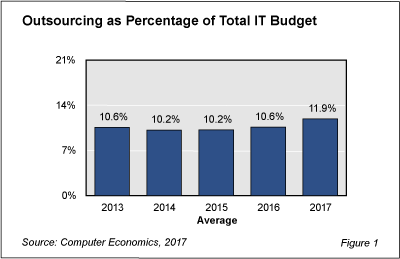IT organizations are committing to outsourcing this year at the highest rate since the Great Recession. The new IT Outsourcing Statistics 2017/2018 study from Computer Economics finds that while organizations aren’t broadly increasing the number of functions they choose to outsource, they are increasing the amount of work they send to outside service providers. In other words, more companies are choosing to tap into certain skills from outside organizations so they can focus on mission critical skills in-house.
As shown in Figure 1 from the full study, the percentage of the total IT budget being spent on outsourcing rose from 10.6% in 2016 to 11.9% in 2017. This represents a major increase as organizations have hovered between 10.2% and 10.6% for the previous four years.

“Not surprisingly, IT security was the fastest growing function being outsourced. The variety of threats and the danger they pose increase yearly,” said David Wagner, vice president of research for Computer Economics, based in Irvine, Calif. “Finding and maintaining the right skills to meet these threats can be a challenge. Turning to experts to supplement internal IT security skills is a wise choice for most organizations. Other areas growing quickly included disaster recovery and network operations. Like security, these are areas that are important, but require specialized skills that are not necessarily core to the business.”
Here are other key findings from our IT Outsourcing Statistics study this year:
-
Outsourcing is becoming more attractive to all organizations. But large organizations are growing IT outsourcing budgets the fastest. At the median, large organizations have increased the percentage of their IT budgets spent on outsourcing from 6.3% to 8.7%. Small organizations are now spending 7.8% of their IT budget on outsourcing at the median this year, compared to 6.7% last year. Midsize companies have increased their spending at the median from 4.7% to 6.5%.
-
Application development is the most-frequently outsourced function in the study. In these times of relatively good economic growth, 37% of organizations that outsource this function are planning to increase the amount of work they outsource. Application development continues to take larger parts of the IT budget, and many IT organizations are looking to optimize internal staffing through selective use of outside development firms.
-
Organizations that outsource are favoring help desk and web operations as functions where they are moving the largest percentage of work to service providers. Much of this work involves commodity skills that many organizations find easy to send to service providers.
-
The IT functions with the greatest potential for successfully reducing costs through outsourcing are help desk, desktop support, disaster recovery, and data center operations. The economies of scale that service providers can offer makes these areas good opportunities for cost savings.
-
The functions with the greatest potential for improving service through outsourcing are IT security, disaster recovery, application maintenance, and database administration. IT security and disaster recovery, especially, are areas where the motivation to outsource has less to do with saving money and more to do with having the job done better than it can be done in-house.
- The outsourcing of disaster recovery delivers the best value when looking at both cost and service delivery. Outsourcing disaster recovery is the only function that has a high cost success and service success rating. For other areas, there is generally a tradeoff between saving money and improving service levels.
In the full study, we profile outsourcing activity for 10 IT functions: application development, application maintenance, data center operations, database administration, desktop support, disaster recovery services, help desk services, IT security, network operations, and web operations.
For each IT function, we measure the frequency and level of outsourcing. We also look at the current plans of IT organizations to increase or decrease the amount of work they outsource. Finally, we examine the customer experience to assess whether organizations are successfully lowering costs or improving service through outsourcing.
This Research Byte is a brief overview of our report on this subject, IT Outsourcing Statistics 2017/2018. The full report is available at no charge for Computer Economics clients, or it may be purchased by non-clients directly from our website (click for pricing).

